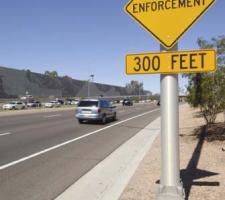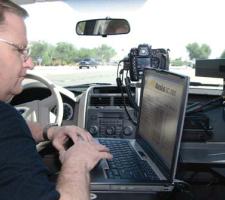
Jim Tuton
Jim Tuton of American Traffic Solutions looks at the evolution of automated enforcement in North America
"Technological regulation will become more sophisticated at the federal level, giving states clearer guidelines" Jim TutonIn just 20 years, photo enforcement in North America has grown from a single speed camera in a small town in Arizona to thousands of photo traffic enforcement cameras which are now operating in 350 communities spread across 27 states and three Canadian provinces. Most of these programmes were implemented within the past five years as both the technology and public acceptance have enjoyed marked improvements.
As the number of photo enforcement programmes in North America have dramatically increased, so have regulations impacting upon the technology. Laws governing how the programmes are managed and how the resulting revenues are dispersed are also growing.
North American and European business models differ
In the European market, photo enforcement vendors typically sell equipment to law enforcement customers. The law enforcement agencies run their own programmes and are well-versed in the local regulations governing photo enforcement.The North American model is to outsource not only the equipment and technology but also most of the administrative functions. Photo enforcement vendors collaborate with their law enforcement partners to run the day-to-day operations. The law enforcement agencies set clear standards, oversee their vendors' work and require strict, auditable quality control systems. This model makes it critical for the vendors to stay current with myriad local, state, provincial and federal laws that regulate the photo enforcement industry. As the industry matures in North America, the laws change frequently.
Federal oversight
TheVendors who provide mobile radar speed enforcement systems must certify the radar equipment with the FCC. Registration is required before equipment is imported into the US as well as before it is deployed. Failure to abide by the FCC regulations is illegal and can subject the vendor to significant financial penalties, sanctions and legal fees.
Guidelines for yellow signal duration
TheMany states have adopted the Federal guidelines as state law. Even if a state hasn't formally adopted the Federal guidelines, most municipalities voluntarily adhere to them. In the instances in which cities have endeavoured to shorten the duration of a yellow signal to increase revenues from red-light cameras, they are invariably caught and public pressure results in the guidelines being adopted and followed.
Vendors have no authority over the timing of yellow signal phases. Only the municipality or agency overseeing the roadway can alter the signal light timing.
Vendors seek voluntary certification
TheAs part of the certification process, independent testing is completed by The Technology Clearinghouse. The Clearinghouse was established in 1997 through a cooperative agreement between the IACP, the FHWA and the
While it's not mandatory for vendors to complete the certification process, more vendors are voluntarily seeking certification and many public procurement programmes require the IACP certification for across-the-road radar systems. Not having certification has become a competitive disadvantage as communities award extra points in competitive bidding processes to vendors with certification.
We anticipate that the IACP will continue to improve its certification requirements and more police departments will adopt IACP certification as a requirement for photo enforcement vendors in the future.
Patchwork of state legislation and regulation
The United States does not have federal, nationwide enabling laws for photo enforcement. Instead, laws and regulations are enacted on the state and local levels.As the popularity of photo enforcement spreads quickly across the continent, state and local lawmakers - from state legislators to local city council members - are scrambling to keep up with this public safety trend and the technological improvements. This has led to a patchwork of local and state laws and regulations governing how American communities are going to use, monitor and regulate photo enforcement. There are also debates about how governmental entities distribute revenues from photo enforcement systems and how the monies will be used.
Four of the 27 states using photo enforcement hold the actual drivers liable (versus the registered owners). This requires 'twin-camera' systems to capture clear photos of drivers' faces (that is, a front image) and images of the licence plates on the rear of the vehicle. Many states specifically prohibit capturing pictures of the actual drivers or anyone inside the vehicles. Some 23 states treat violations like parking tickets. The registered owners of the vehicles are responsible for speeding and red-light violations caught on camera. Different states and communities provide varying options for registered owners to transfer liability to the person who was operating the vehicle.
Last year, New Jersey passed legislation creating a five-year pilot programme for photo enforcement. Louisiana passed legislation that prohibited 'points' being assessed against violators' drivers' licences. Massachusetts and Wisconsin are in the process of trying to get legislation passed to enable state-wide photo enforcement. Connecticut is among the states debating regulatory and enabling legislation. Bills that would have expanded photo enforcement programmes failed in Alabama, Illinois, New York and Missouri during the last legislative sessions but new efforts in support of photo enforcement are underway in those states in 2009. The governor of Colorado proposed legislation to expand photo enforcement for speed cameras on state roadways similar to legislation passed in Maryland last year.
While supporters of photo enforcement are seeking laws that would expand speed and red-light camera programmes, vocal opponents are introducing legislation that bans photo enforcement outright or would effectively kill local programmes. Major legislative battles are currently brewing in Arizona, Florida, Tennessee, Mississippi and Missouri. Voters in Washington State recently voted down a citizen initiative that would have killed photo enforcement in that state.
Public opinion polls indicate that the general public overwhelmingly supports photo traffic safety enforcement. Support for red-light cameras routinely polls in the 70-80 per cent range, while support for speed cameras polls between the high sixties and high seventies across the country.
Local communities adopting ordinances
When no enabling state legislation is in place, local communities are adopting their own ordinances so they can move forward with photo enforcement. When a bill in the Florida legislature failed last year, more than 30 Florida cities, towns and counties adopted their own regulations.Arizona has no enabling legislation regulating photo enforcement in local communities but nearly every major city in the state features photo enforcement programmes. Arizona passed a law last year establishing the country's first state-wide photo enforcement programme. This authorises the state to deploy as many as 100 cameras in the programme's first phase.
While both the state and local programmes hold the actual drivers responsible, a violation issued by a city results in points on the drivers' licences and a report to their insurance company. A violation issued by the state carries no points and isn't reported to insurance companies.
Legislative battles over who gets the money
Given the tough economic situation and lagging state revenues, there are battles raging over who gets the revenues from photo enforcement programmes. There is a trend toward state legislatures either trying to assert control over the local programmes or to grab a share of the revenues.Texas has a law that sets the fine for red-light running at $75 per occurrence. Half the net revenue after costs is designated for the state's trauma fund. New Mexico passed a law that also set the maximum fines at $75 and designated that most of the revenue generated from the state's largest local photo enforcement programme must flow to the state coffers.
In Oregon, some legislators are seeking to prevent municipalities from earning more than 5 per cent of their annual revenue from photo-enforcement programmes. In Arizona, the amounts of the fines are different among all the cities, while a set fine has been established for the statewide programme. A portion of the fines from the local programmes are designated for various state funds.
Increased programme monitoring
Several state departments of transportation, including New Jersey, Colorado and Virginia, review intersection violation and crash data before allowing local municipalities to install cameras. Texas now requires citizen review boards in each community using photo enforcement. Texas also requires all cities using photo enforcement to participate in an annual assessment of programme results. The first report, delivered to the legislature in 2008, reviewed dozens of programmes and found that crashes were reduced by 30 per cent.Individual cities across North America are tracking the results of speed and red-light enforcement. They report the results to their citizens on a regular basis and use the data to modify their programmes, moving red-light cameras to higher-risk intersections once violations decrease after several months of monitoring by cameras.













